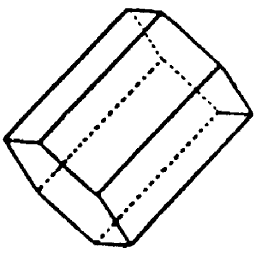 |
Science Frontiers ONLINE No. 123: May-Jun 1999 |
|
|
Copper Pseudomorphs

There are two places in the world where large masses of native (almost pure) copper are common: the Lake Superior region, particularly Isle Royale, and Corocoro, Bolivia. The largest "nugget" of nearly pure copper comes from Lake Superior and weighs almost 46 tons! But the Corocoro mines are rich in another way; copper "pseudomorphs." In copper pseudomorphs, copper ions insidiously invade crystals of other minerals and assume their shapes. Copper pseudomorphs of aragonite, a form of CaCO3 , are common.
Aragonite sometimes occurs as short, tabular, hexagonal prisms, as shown in the sketch. Under the water table, in a copper-rich area, copper ions in solution "attack" aragonite crystals. First, they oust and replace the outer layers of CaCO3 , gilding the aragonite crystal with a thin layer of pure copper. Then, they work inwardly and eventually usurp the whole crystal and take on its shape.
Even stranger are those hexagonal crystals that are pure aragonite in the top half and pure copper in the bottom half. Mineralogists speculate that these formed along the edge of the water table.
(Hyrsl, Jaroslav, and Petrov, Alfred; "Pseudomorphs from Bolivia," Rocks and Minerals, 73:110, November/December 1998.)